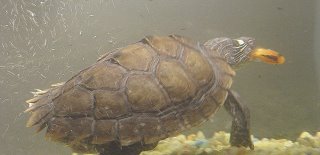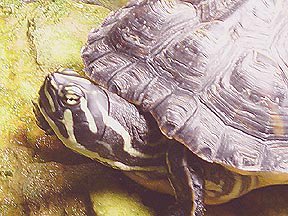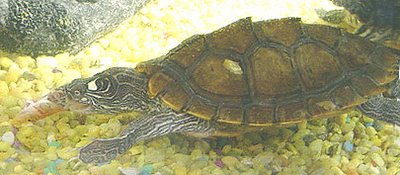JAMESTOWN, N.D. -- Earlier this summer, Betty Kratzke noticed that something was  disturbing the ground near the flowers that line her driveway. Solving the mystery this week proved to be a snap - when baby snapping turtles started crawling around her yard. "They just keep popping up out of the hole," said Cliff Hanson, Kratzke's brother-in-law. The turtles had recently hatched and were no bigger than a half dollar coin, said Darrell Perry, another brother-in-law. Family members scooped up 44 turtles in all. They were put in a cardboard box and taken to the nearby James River. "They went swimming away like crazy," Kratzke said.
disturbing the ground near the flowers that line her driveway. Solving the mystery this week proved to be a snap - when baby snapping turtles started crawling around her yard. "They just keep popping up out of the hole," said Cliff Hanson, Kratzke's brother-in-law. The turtles had recently hatched and were no bigger than a half dollar coin, said Darrell Perry, another brother-in-law. Family members scooped up 44 turtles in all. They were put in a cardboard box and taken to the nearby James River. "They went swimming away like crazy," Kratzke said.
Snapping turtles live to be decades old and can grow up to 40 pounds, said Gene Van Eeckhout, a biologist with the North Dakota Game and Fish Department. They do not make nice pets, he said. "They're not very friendly to play with," Van Eeckhout said. Kratzke said she thought some sort of animal was disturbing her flowers. "But it was a long ways from being a muskrat or a raccoon," she said. "They are the cutest little things." Perry said the experience was one to remember. "While they were coming out, we just stood there and watched them in amazement," he said.
 disturbing the ground near the flowers that line her driveway. Solving the mystery this week proved to be a snap - when baby snapping turtles started crawling around her yard. "They just keep popping up out of the hole," said Cliff Hanson, Kratzke's brother-in-law. The turtles had recently hatched and were no bigger than a half dollar coin, said Darrell Perry, another brother-in-law. Family members scooped up 44 turtles in all. They were put in a cardboard box and taken to the nearby James River. "They went swimming away like crazy," Kratzke said.
disturbing the ground near the flowers that line her driveway. Solving the mystery this week proved to be a snap - when baby snapping turtles started crawling around her yard. "They just keep popping up out of the hole," said Cliff Hanson, Kratzke's brother-in-law. The turtles had recently hatched and were no bigger than a half dollar coin, said Darrell Perry, another brother-in-law. Family members scooped up 44 turtles in all. They were put in a cardboard box and taken to the nearby James River. "They went swimming away like crazy," Kratzke said.Snapping turtles live to be decades old and can grow up to 40 pounds, said Gene Van Eeckhout, a biologist with the North Dakota Game and Fish Department. They do not make nice pets, he said. "They're not very friendly to play with," Van Eeckhout said. Kratzke said she thought some sort of animal was disturbing her flowers. "But it was a long ways from being a muskrat or a raccoon," she said. "They are the cutest little things." Perry said the experience was one to remember. "While they were coming out, we just stood there and watched them in amazement," he said.
Observation: Those snapping turtles are sold for $25.-$30. each at the local pet store. I would love to have one. I had one a while back but it died after a couple of years. Turtles need a lot of attention to their water filtration, nutrition, and sunlight or UV lighting. It takes a lot of commitment and responsibility.







 The Musk turtle is getting bigger. Now that this one and the Texas Mud turtle are in their own tank, I think they will do better. The larger turtles in the other tank have a tendency to nip at the smaller turtles.
The Musk turtle is getting bigger. Now that this one and the Texas Mud turtle are in their own tank, I think they will do better. The larger turtles in the other tank have a tendency to nip at the smaller turtles.










